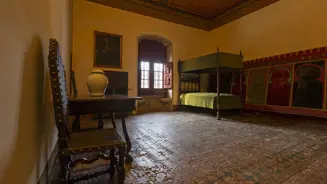Did King Afonso VI really leave marks on the floor of his room from walking so much from one side to the other?
02 Feb 2023

Anyone who has visited the National Palace of Sintra has heard about the floor marked by the footsteps of King Afonso VI. But is the wear and tear on the flooring actually related to the imprisonment of the Portuguese king?
Let's take a trip back in time. King Afonso VI, son of King João IV and Queen Luísa de Gusmão, ascended to the throne in 1656. He received the epithet 'The Victorious', as it was during his reign that the Restoration War came to an end (1668). But, shortly after this conquest, King Afonso would end up being removed from the throne by his brother, the future King Pedro II, who declared him physically and mentally incapable. Afonso spent the rest of his reign isolated: first on Terceira Island, in the Azores, and then at Palace of Sintra, where he would eventually die, after nine years of confinement.
The king was confined to his room. He was guarded by 300 soldiers and could only leave his quarters to attend mass. Hence the legend that the marks we see on the floor today were left by the footsteps of King Afonso VI, who spent his days walking from one side of his small room to the other. How true is this assertion?
Afonso may have actually left the marks on the tiled floor of that chamber. When he was a child, just three or four years old, he was struck down by a “malignant fever” that left him with hemiparesis, in other words, it caused him difficulty moving the right side of his body. Therefore, it was normal for him to drag his right leg and thus cause greater wear to the tiles.
But would this physical problem of the king be enough to leave such deep marks on the floor of his room? The curator of the National Palace of Sintra, Cláudio Marques, recalls that the floor of that chamber dates back to c. 1440 and that the king was in those apartments from 1674 to 1683, some 230 years later. In other words, it would have been normal for the floor to show some wear and tear when King Afonso VI lived there. “Furthermore, there is no part of the flooring that has gone untouched by the marks of time. Now, if the king had worn the floor with his steps, this would only be noticeable in one area of the room and not across the entire floor area, given the placement of furniture such as the bed, table and chairs”, explains the curator. It is also known that, in the final years of his life, Afonso had more and more motor difficulties - he was even carried in arms to attend mass at the tribune of the chapel of the Palace of Sintra.
With all these factors in mind, it is possible to say that yes, King Afonso VI did wear the floor down a little in the room where he lived until he died, but its state of conservation is not due to his incessant footsteps.
CONCLUSION: myth, with a possible foundation of truth.
